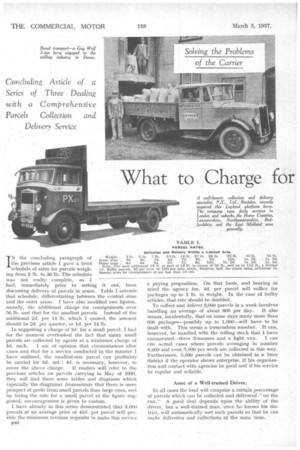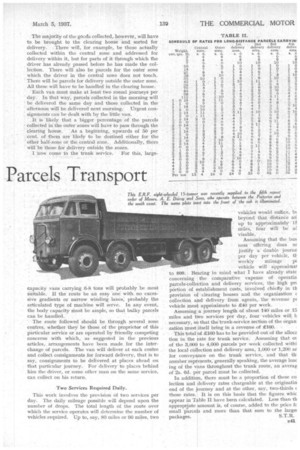What to Charge for
Page 58

Page 59

If you've noticed an error in this article please click here to report it so we can fix it.
i COS i 1 4 0
3 10 6 4 8 2 4 16 0
Parcels Transport Per ton 13 24 0 33 0
6 6 8 3
IN the concluding paragraph of the previous article I gave a brief schedule of rates for parcels weighing from 3 lb. to 56 lb. The schedule was not really complete, as I had, immediately prior to setting it out, been discussing delivery of parcels in zones. Table I amends that schedule, differentiating between the central zone and the outer areas. I have also modified two figures, namely, the additional charge for consignments over 50 lb. and that for the smallest parcels. Instead of the additional 2d. per 14 lb. which I quoted, the amount should be 2d. per quarter, or 1d. per 14 lb.
In suggesting a charge of 3d. for a small parcel, I had for the moment overlooked the fact that many small parcels are collected by agents at a minimum charge of
1d. each. I am of opinion that circumstances alter cases and that for a service conducted in the manner I have outlined, the smallest-size parcel can profitably be carried for 3d. net. 4d. is necessary, however, to
cover the above charge. If readers will refer to the previous articles on parcels carrying in May of 1936, they will find there some ta.bles and diagrams which (specially the diagrams) demonstrate that there is more prospect of profit from small parcels than large ones, and by fixing the rate for a small parcel at the figure suggested, encouragement is given to custom.
I have already in this series demonstrated that 3,000 parcels at an average price of 4id. per parcel will provide the minimum revenue requisite to make this service B40 a paying proposition. On that basis, and bearing in mind the agency fee, 4d. per parcel will suffice for packages up to 3 lb. in weight. In the case of bulky articles, that rate should be doubled.
To collect and deliver 3,000 parcels in a week involves handling an average of about 600 per day. It also means, incidentally, that on some days many more than 600 packages-possibly up to 1,000-will have to be dealt with. This seems a tremendous number. It can, however, be handled with the rolling stock that I have enumerated-three 3-tonners and a light van. I can cite actual cases where parcels averaging in number 4,000 and even 5,000 per week are collected in this way. Furthermore, 5,000 parcels can be obtained in a busy district if the operator shows enterprise, if his organization and contact with agencies be good and if his service be regular and reliable.
Asset of a Well-trained Driver.
In all cases the load will comprise a certain percentage of parcels which can be collected and delivered "on the run." A good deal depends upon the ability of the driver, but a well-trained man, once he knows his district, will automatically sort such parcels so that he can make deliveries and collections at the same time. capacity vans carrying 0-8 tons will probably be most suitable. If the route be an easy one with no excessive gradients or narrow winding lanes; probably the articulated type of machine will serve. In any event, the body capacity niust be ample, so that bulky parcels can be handled.
The route followed should be through several zone centres, whether they be those of the proprietor of this particular service or are operated by friendly competing concerns with which, as suggested in the previous articles, arrangements have been made for the interchange of parcels. The van will deliver at each centre and collect consignments for forward delivery, that is to say, consignments to be delivered at places ahead on that particular journey. For delivery to places behind him the driver, or some other man on the same service, can collect on his return.
Two Services Required Daily.
This work involves the provision of two services per day. The daily mileage possible will depend upon the number of drops. The total length of the route over which the service operates will determine the number of vehicles required. Up to, say, 80 miles or 90 miles, two • vehicles -would suffice, bi
beyond that distance an up to approximately l miles, four will beae visable.
Assuming that the bus ness offering does m justify •a• double journe per day per vehicle, th weekly mileage pt vehicle will approximal to 800. Bearing in mind what I have already state concerning the comparative expense of operatin parcels-collection and delivery services, the high prc portion of establishment costs, involved chiefly in th provision of clearing houses and the Organization ( collection and delivery from agents, the revenue pf vehicle must approximate to 240 per week.
Assuming a journey length of about-140 miles or 15 miles and two services per day, four vehicles will b necessary, so that the 'trunk-service section of the organ zation must itself bring in a revenue of 2100. • This total of 2160 has to be provided out of the alloca tion in the rate for trunk service. Assuming that or of the 3,000 to 4,000 parcels per week collected withi the local collection and delivery area, 1,000 or 1,200 ar for conveyance on the trunk service, and that th number represents, generally speaking, the average loa.c ing of the vans throughout the trunk route, an averag of 2s. 6d. per parcel must be collected.
In addition, there must be a proportion of these co lection and &livery rates chargeable at the originatin end of the journey and at the other, say, two-thirds c those rates. It is on this basis that the figures whic appear in Table II have been calculated. Less than th appropriate amount is, of course, added to the price fc small parcels and more than that sum to the large: packages. S.T.R.




































































































